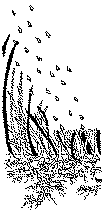 Bagging grass clippings and throwing them out with the trash robs your lawn of valuable nutrients. Grass clippings from a properly mowed lawn are a fertilizer resource. Left on the lawn after mowing, the clippings reduce the amount of fertilizer needed for a healthy lawn and reduce the potential for fertilizer to move into the water system. Leaving grass clippings on the lawn also saves your local government the cost of disposing of them at area landfills. During peak growing periods, usually in April or May, it may be necessary to collect grass clippings. If you must gather up the clippings, add them to your yard's compost pile for later use as mulch.
Bagging grass clippings and throwing them out with the trash robs your lawn of valuable nutrients. Grass clippings from a properly mowed lawn are a fertilizer resource. Left on the lawn after mowing, the clippings reduce the amount of fertilizer needed for a healthy lawn and reduce the potential for fertilizer to move into the water system. Leaving grass clippings on the lawn also saves your local government the cost of disposing of them at area landfills. During peak growing periods, usually in April or May, it may be necessary to collect grass clippings. If you must gather up the clippings, add them to your yard's compost pile for later use as mulch. Soil Test
Before you plant grass seed or fertilize your lawn, pick up a soil test kit from your local Extension Office, dig up a soil sample, and have it tested. The soil report will tell you in plain language whether you need to apply lime to restore the soil's natural chemical balance. It will also tell you what kind of fertilizer is needed and how much you should use. The cost for the test is $7.00.
Mow Regularly
Proper mowing is as important to the success of a well-kept lawn as any other step. Although recommended cutting heights vary by type of grass, a good "rule of thumb" is to cut off no more than one-third of the grass plant at any mowing. Set the mower height accordingly, but no lower than 1-1/2 inches. Weekly mowing should be often enough except in April and May, the months of peak grass growth.
Fertilize in the Fall
Fall fertilizer applications are most beneficial to the cool season lawn grasses found in Virginia. Apply the amounts of lime and fertilizer nutrients (nitrogen, phosphorus and potassium) recommended in your soil test report. Applications of fertilizers containing nitrogen should be made from September through December. By leaving grass clippings on the lawn, it is estimated that you will reduce nitrogen applications 20% to 30% after the first year and 35% to 45% after the second year.
Water as Needed
Except during the most severe drought, grasses common to Virginia will survive without watering. If you wish to maintain a green yard in dry weather, add about 1 inch of water a week, preferably in the early morning and only as much as will soak into the ground. Water that is allowed to run off carries with it nutrients that are valuable to the lawn but harmful to streams and reservoirs.
By following these guidelines, homeowners in Virginia can expect to save money on fertilizer as well as plastic trash bags. Annual homeowner savings for a typical quarter-acre lot amount to $20 to $45 in fertilizer costs and $20 to $40 for plastic bags. In addition, you will help your local government keep a lid on refuse disposal costs. A typical quarter-acre lot generates 3,500 to 4,000 pounds of grass clippings a year. Disposing of them costs the homeowner $50 to $90 a year in public service charges, private collector fees, or taxes.
No comments:
Post a Comment